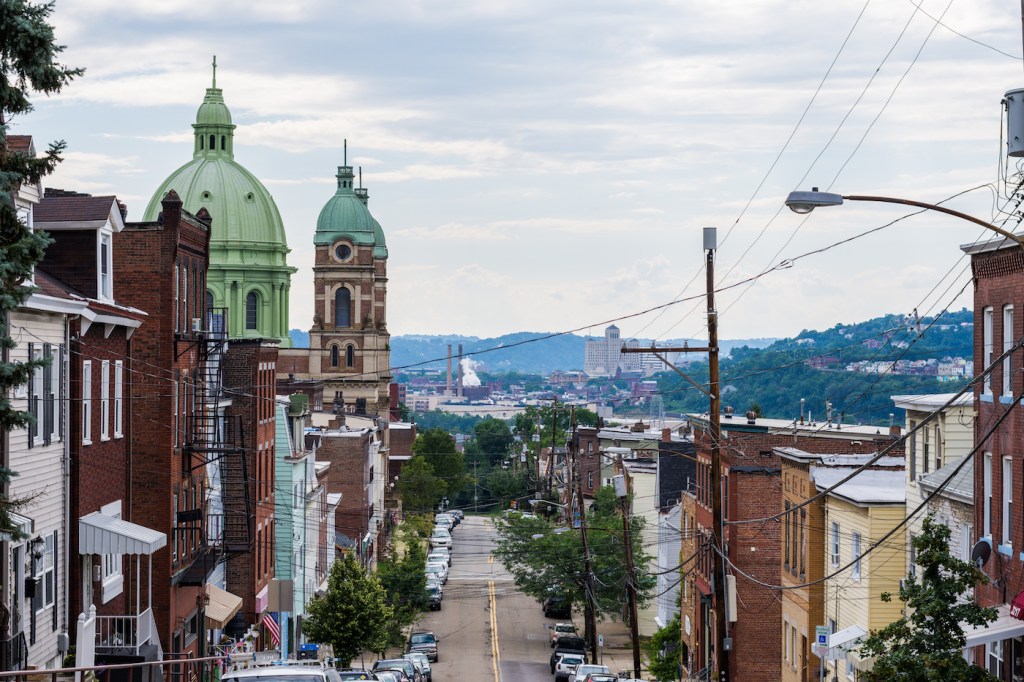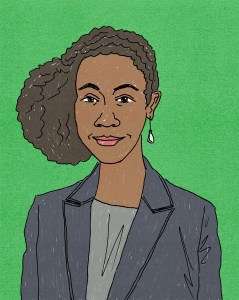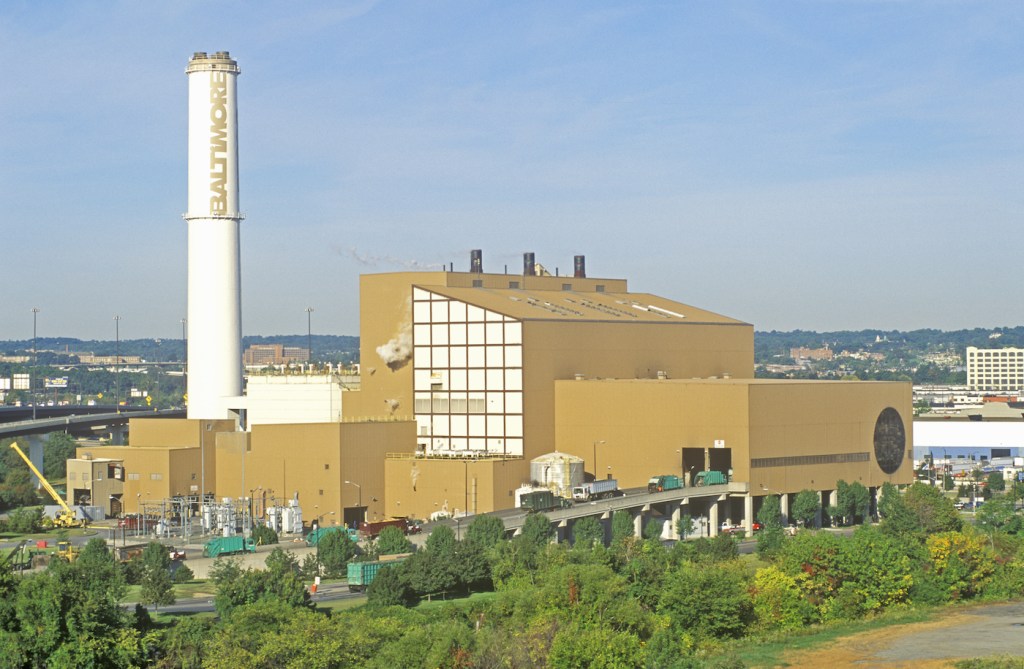20 Years Later, How Are City Climate Plans Actually Going?
17:15 minutes

 In 2005, countries around the world ratified the Kyoto Protocol. It was the first big, legally-binding international climate policy, but there was a big drawback: The United States, the world’s richest country and second-highest emitter, didn’t ratify it.
In 2005, countries around the world ratified the Kyoto Protocol. It was the first big, legally-binding international climate policy, but there was a big drawback: The United States, the world’s richest country and second-highest emitter, didn’t ratify it.
In response, American mayors took action. Even if the US wouldn’t commit to cutting climate emissions, their cities would. It was the classic “think global, act local” move.
It started with mayoral resolutions—a bunch of “whereases” laying out the reasons cities needed their own climate targets. Whereas manmade climate change is happening. Whereas cities are responsible for 70% of the world’s emissions. Whereas more than half the world’s people live in cities. Whereas cities are most vulnerable to the effects of climate change.
Therefore? Our city is going to do something about it. Mayors proclaimed, city councils adopted, and gavels cracked on podiums across the country as city climate plans were created, along with a new job to manage it all: the chief sustainability officer.
Twenty years later, hundreds of US cities have climate plans. Their chief sustainability officers are responsible for aggressive decarbonization goals that require deep cuts to emissions, and fast. But are cities actually meeting their targets? And do city sustainability officers have what they need to meet them?
“The state of decarbonization is lopsided. It’s really imbalanced in this country,” says Hilari Varnadore, a vice president at the U.S. Green Building Council, where she oversees a national program that helps cities with sustainability goals. “We have places—cities and states—that are just really accelerating progress, big time. And then there [are] just places that it’s moving super slow.”
Cities don’t count emissions the same way. While most use a tool called a greenhouse gas inventory, what they include in the inventory varies a lot. Some track emissions from all activities within city limits. But others only track municipal operations, like city vehicle fleets and government buildings, because it’s the only data they can get.
What’s more, cities have different targets, different baseline years and different future deadlines by which they aim to meet their targets. For example, many cities have what’s known as an 80-by-50 goal—a goal to reduce emissions by 80% by the year 2050. It’s a goal that’s roughly aligned with what scientists said would limit global warming to about 2 degrees Celsius when the Kyoto Protocol became official.
But the science has changed. Since 2018, the United Nations Intergovernmental Panel on Climate Change has recommended limiting global warming to 1.5 degrees Celsius to avoid the worst effects of climate change. To get there, scientists say global emissions must be cut as fast as possible—to net zero by 2050, with an interim reduction target of about 50% by 2030.
Varnadore’s career has tracked the story of US city climate planning, pretty much beat by beat. She graduated from high school in 1993, the same
year the city of Portland, Oregon, became the first in the country to adopt a climate plan. She became a planner in Frederick County, Maryland, in 2005,
the same year the Kyoto Protocol took effect. When Frederick County signed on to the national Mayors Climate Protection Agreement two years later, she became their first sustainability director.
“It was happening all over the country,” Varnadore says. As more cities hired sustainability directors, national networks brought them together at conferences, where Varnadore says they had a lot of the same questions. “What is sustainability? … What are we measuring and how do we measure it? And when do we know that we’ve met the target?”
Now, hundreds of US cities have their own climate action plans, but the ground is still shifting under
these fundamental questions. It makes it difficult to
pin down, on average, just how much climate
progress cities have made across the country.
But among the four cities included in this story, Baltimore and Pittsburgh have cut greenhouse gas emissions by around 20%. Denver and Portland, Oregon, have cut emissions by about 30%.
And each of these cities has a story about caveats—why the results may not be as good as they look, or why the deeper cuts required may be very difficult.
In Pittsburgh, for example, building sector emissions have been like a game of Whack-A-Mole. While commercial building emissions fell by 27% over the last decade, residential buildings offset much of that progress, rising by 22%.
One reason for the city’s success in cutting commercial building emissions is that Pittsburgh’s downtown is a high-performing building network known as a 2030 District. The city has the largest 2030 District in the country. But Pittsburgh is also among the top ten cities nationwide where families have the highest energy burden.
“Our houses are bad, our houses are leaky and they’re old,” says Flore Marion, the acting assistant director for sustainability and resilience in Pittsburgh. “The winter bills are just so high that people have to make tough choices … between their utility bill and food.”
The country’s first city climate plan was Portland, Oregon’s 1993 Global Warming Reduction Strategy. It’s a text-only, two-page document, written back when—as the writers put it—“the effects of global warming [would] take time to be apparent.” It sets a goal of reducing emissions by 20%, and lays out a few bullet points detailing how to do it.
And that’s how many city climate plans were for many years. Although they got much longer, with slicker graphic design, they largely focused on carbon.

But contemporary climate plans are more than carbon plans. They are also increasingly becoming resilience plans and equity plans. That’s because now the effects of global warming are apparent, and cities are grappling with actual climate change impacting frontline communities.
“We don’t have to convince people [climate change] is happening. They’re believing it,” Marion said on a February day in Pittsburgh. “This is not Pittsburgh winter. The snow melts in two days.”
Marion says Pittsburgh is lucky to have abundant greenways and urban forests, but the increase in rainfall has made the city’s hilly terrain prone to landslides.

“That’s a huge budget cost for us,” Marion says.
An old cliché about city government is that all it does is repair potholes. But now that cities are experiencing the effects of climate change, it’s as if landslides are the new potholes—along with drought, flooding, wildfires, and deadly heat domes.
Baltimore’s newest climate plan names environmental justice and alleviating unequal environmental burdens as its first guiding principle. That’s a significant tone shift from the city’s 2012 plan, which opened with climate science and the predicted local effects of climate change.
“We had some amazing community members that were honest and provided us some really, really tough feedback,” says Ava Richardson, Baltimore’s sustainability director. “While greenhouse gas emissions is a very important measure that we want to track and we need to track, that’s not the thing that probably is most important to people on an everyday basis.”
Baltimore’s waste sector, for example, is responsible for a relatively small proportion of the city’s carbon emissions—about 5%. But in South Baltimore, there’s a massive trash incinerator in the middle of a mostly-Black community. The people there are suffering very real health impacts from breathing air polluted by burning trash. If you only look at the carbon impacts of waste, you can miss the bigger picture.

In its latest climate plan, Portland has also shifted its focus from carbon to communities. Vivian Satterfield, Portland’s chief sustainability officer, says her office’s anti-displacement plan explicitly addresses one way a narrow focus on decarbonization can harm frontline communities. Imagine a landlord taking advantage of city incentives to make energy efficiency retrofits to a privately-owned apartment building.
“Without having an anti-displacement lens, a building owner could … say well, now this all justifies me raising the rent significantly and finding new tenants who are willing to pay a much higher premium for these climate-friendly and climate-secure amenities,” Satterfield says. “As opposed to ensuring that the folks who are the most energy-cost burdened in our community are the ones who are actually receiving the greatest benefit.”
Cities are up against real barriers when it comes to acting on their climate plans. One of these is the very idea that a chief sustainability officer alone could manage it all.
“I think there was this mythology for a long time, both in the public sector and in the corporate world that one person—a chief sustainability officer—is going to somehow just change all the systems and then everything will be sustainable. And that’s all you need to do,” says Elizabeth Babcock, executive director of Denver’s Office of Climate Action, Sustainability and Resiliency.

Many cities don’t have a chief sustainability officer. But among those that do, that person typically has few or no staff and a tight budget.
For some sustainability officers, this has meant getting trapped in a cycle of creating climate action plans, a multi-year process of drafting, stakeholder input, and adoption. The planning begets a cycle of reporting on the plan, which often includes doing greenhouse gas inventories.
“Data is not easy to get,” Marion says. “Right now we often still send emails to get the information. ‘Hey, it’s the end of the year. Do you have the information for this year?’ And then we get a spreadsheet that we enter into our system.”
Pittsburgh completed a greenhouse gas inventory in 2013, and then another in 2022. The data showed that between the two inventories, the city’s emissions had plateaued. That means the city met its goal of reducing emissions 20% by 2023 10 years early, but there was no progress after that—and they didn’t know until the latest inventory.
“There’s a lot of places that are a bit stuck,” Varnadore says. “They have this great plan. It’s very actionable. But then the big question is so, okay, now what?”
One thing that could be on the horizon for more city climate offices is more funding.
In 2015, the Kyoto Protocol was replaced by the Paris Agreement, and in 2019, the US gave notice that it would withdraw from it. Once again, communities across the country took action in the form of protests and new climate commitments—and more mayoral resolutions.

In Denver, a community task force developed another climate plan of sorts: a set of recommendations. But unlike many climate plans, one of the recommendations was a sales tax increase to fund the work. In November of 2020, a day before the withdrawal from the Paris Agreement took effect, Denver voters passed the 0.25% sales tax with more than 60% of the vote.
“It was very exciting. Game changing,” Babcock says. “Rather than basically constantly doing planning—and that’s all you’re doing—you’re actually able to scale and implement in a way that a lot of places are not able to.”
The Denver sustainability office’s budget increased from about $1 million a year to more than $40 million a year. While the funding isn’t enough to pay for large infrastructure projects, like public transit, the office can use its funds to apply for grants, build partnerships, and leverage policy changes.
Another change some cities may undertake is tracking a category of emissions most aren’t counting at all: consumption-based emissions. Most cities only count emissions from activities within city limits, such as driving and powering buildings. But cities are net importers of everything from cement to food to Amazon packages. Those resources are produced somewhere else, and they come with carbon emissions.
Portland is one of a handful of US cities counting consumption-based emissions.
“We’re Americans,” says Vivian Satterfield, Portland’s chief sustainability officer. “We have to talk about the consumption-based emissions because we are consumers more than anything.”

Portland has found its consumption-based emissions are nearly twice as high as the carbon generated within the city. This is likely to be true for most cities. It raises questions about the ability of cities to track these emissions, but also to meet science-based climate targets on a global scale.
“Can we get to zero globally while maintaining the level of consumption that we have today?” asks Kyle Diesner, a climate policy analyst for Portland. “I think the answer is no. … And that is very challenging and there’s a lot of questions about the role of government in that conversation.”
And across the country, city sustainability staff are learning to cope with climate grief and the difficulty of the tasks ahead of them. In Pittsburgh, Marion is working to find more joy in her daily work.
“I think there’s lots of anxiety around climate. It’s happening,” Marion says. “We’re not just working to remove carbon from the air. We’re not working to make the world a better place in 20 years. We also want to make life better for us right here, right now.”
One of her recent joys is a very appropriate one for a city sustainability officer: Pittsburgh’s celebrated new stormwater code, which requires developers to design for heavier future rainfall in a climate-changing world.
“I don’t know if we’re going to do all of the work on time,” Marion says. “But if we remember to be present in the moment and take every little win … that’s how we’re going to keep moving forward and get things done.”
Susan Scott Peterson is a climate reporter based in Pittsburgh, Pennsylvania.
KATHLEEN DAVIS: This is Science Friday. I’m Kathleen Davis.
JOHN DANKOSKY: And I’m John Dankosky. Climate change is a global issue. And so when we think about getting carbon out of the atmosphere, we often think about really big policies. I’m talking about international treaties and federal infrastructure bills worth billions of dollars. But–
[GAVEL BANGING]
SPEAKER 1: Good evening, everyone. And welcome to Pittsburgh City Council’s public hearing for today.
JOHN DANKOSKY: –climate policy happens closer to home too.
SPEAKER 2: Bill 2028, resolution adopting the Pittsburgh Climate Action Plan, which identifies targets and strategies for greenhouse gas emissions for the city of Pittsburgh.
JOHN DANKOSKY: Over the last 30 years, hundreds of cities across the US have adopted their own plans to cut emissions. But are city governments on track to meet these commitments? And what can one city really do about a global problem? Susan Scott Peterson is a climate reporter in Pittsburgh, who’s been covering this. Welcome to Science Friday, Susan.
SUSAN SCOTT PETERSON: Thanks so much for having me.
JOHN DANKOSKY: OK, to start off, tell me why exactly you’ve been reporting on climate policy in cities.
SUSAN SCOTT PETERSON: Well, it actually started because I had something I was curious about, about my past, because I used to work in city government. This was back when I was in my 20s. And I was in Austin and so young and naive and wearing business casual to the office every day. And this was back in 2008. And we had a climate protection plan for the city.
And I remember feeling, at the time, like, climate change is huge and big and scary and urgent. But we have a plan, right? And so a few years later, 2020 came around. And I just remember wondering, like, whatever happened to that? Did we ever meet any of those goals.
JOHN DANKOSKY: You know, it’s a great question because I remember having the same questions when I started to see these goals come across from different cities, because climate change is a global issue. So what difference do you think a city climate plan can actually make?
SUSAN SCOTT PETERSON: OK, I’m going to start by just telling you a little bit about the history of this. It got started back in 2005 when the world ratified the Kyoto Protocol, which was the first big international climate treaty. But the US didn’t ratify it. And that’s how cities got involved.
I talked to this woman named Hilari Varnadore.
HILARI VARNADORE: Hilari is like “hilarious,” H-I-L-A-R-I. And then Varnadore is V as in Victor.
SUSAN SCOTT PETERSON: And she is the Vice President for Cities at the US Green Building Council. And she told me when the US didn’t ratify Kyoto, that was when city mayors all over the country decided to do something about it. So they got together and they signed on to an agreement that was kind of like their own mini Kyoto Protocol. And they made climate promises for their cities.
HILARI VARNADORE: So this was like our first big wave of mayors saying, even if our country isn’t going to sign on and participate, we’re right here in the front lines.
SUSAN SCOTT PETERSON: And so all of this happened almost 20 years ago now. And today, there are hundreds of cities across the US that have their own climate policies.
JOHN DANKOSKY: So the idea this is a bunch of cities with climate targets is better than nothing?
SUSAN SCOTT PETERSON: Yeah, I think that’s kind of it. But I also think there are other good reasons for cities to have climate plans. One of them is that something like 70% of greenhouse gas emissions come from cities. And so if you want to go after climate change, you really need policies at the city level.
And the other thing is that cities are also where a lot of the climate impacts are happening. There are a lot of people living in cities. There’s a lot of expensive infrastructure and resources to support them. And so when there’s something like a heat wave or a flood or a hurricane, cities are really vulnerable.
JOHN DANKOSKY: OK. So when we’re talking about a city climate plan, what exactly is it? What does one of these things look like?
SUSAN SCOTT PETERSON: So in the beginning, it was mostly mayors making proclamations and resolutions. This is Hilari Varnadore again.
HILARI VARNADORE: It was just like a lot of whereases– whereas– whereas we’re going to do this, this, and this. And then it was more, how do we make this real?
SUSAN SCOTT PETERSON: So eventually, cities needed to put someone in charge of actually doing something. And so they created a totally new job.
VIVIAN SATTERFIELD: My name is Vivian Satterfield. And I’m the Chief Sustainability Officer at the city of Portland.
AVA RICHARDSON: Ava Richardson, Sustainability Director for the Baltimore City office.
ELIZABETH BABCOCK: My name is Elizabeth Babcock. I’m the Executive Director of Denver’s Office of Climate Action Sustainability.
FLORE MARION: I’m Flore Marion. I’m the Assistant Director for Sustainability and Resilience.
SUSAN SCOTT PETERSON: And these city sustainability officers were in charge of figuring out how to turn the mayor’s resolutions–
HILARI VARNADORE: I call them the whereases. I actually do. [LAUGHS]
SUSAN SCOTT PETERSON: –into this thing we call a climate action plan, which is basically a document with a bunch of different strategies like adding renewable energy or building bike infrastructure or capturing methane from landfills. And all of those strategies roll up to a climate goal.
JOHN DANKOSKY: OK, a climate goal. What exactly is a climate goal?
SUSAN SCOTT PETERSON: So it’s usually a decarbonization goal with a deadline. So, for example, a lot of cities have an 80% by ’50 goal. And that means an 80% reduction in carbon emissions by the year 2050.
JOHN DANKOSKY: OK, I’ve heard of a lot of these. What exactly is a target like that based on? I mean, is there any science that goes into making these goals?
SUSAN SCOTT PETERSON: Yeah. So the 80% by ’50 goals are roughly aligned with what scientists said would limit global warming to about 2 degrees Celsius. But this was back around the time of the Kyoto Protocol. And the science has changed.
So now scientists say we should limit warming to 1 and 1/2 degrees Celsius. And so to get there, global emissions have to be cut as soon as possible to net zero by the year 2050. And most cities haven’t adopted that target yet.
JOHN DANKOSKY: Yeah, we see this in a lot of areas of science policy. There’s this huge lag time between the science and the actual policy.
SUSAN SCOTT PETERSON: Right. And I guess I’ll also add that it is hard for cities to update their carbon targets when they’re in the middle of dealing increasingly with actual climate change all at the same time.
FLORE MARION: We have lots of greenways and urban forests. We’re very lucky in that sense.
SUSAN SCOTT PETERSON: Flore Marion directs sustainability in Pittsburgh, which is where I live. And she told me about a climate-related issue that’s started cropping up here.
FLORE MARION: But it also comes with lots of issues around invasive species and precipitation. And so the amount of landslide happening around the city are increasing. And that’s a huge budget cost for us.
SUSAN SCOTT PETERSON: And that really struck me, what she said about landslides being a huge budget cost, because I feel like one of the old cliches about city government is that all they do is run around fixing potholes. But it’s almost like landslides are becoming the new potholes, along with drought and heat domes and flooding.
JOHN DANKOSKY: Yeah. Actually, in Pittsburgh, I saw pictures this spring. The three rivers were flooding major highways. So this isn’t really theoretical there anymore.
SUSAN SCOTT PETERSON: Yeah. We actually have a part of one of our parkways known as the bathtub. Yeah, it’s very immediate. It’s real. And I think it’s making clear that city climate planning isn’t only about counting carbon. It’s also about adaptation and resilience and equity. And it’s about who’s exposed to climate change and environmental risk on a daily basis.
I was talking to Ava Richardson, who’s the sustainability director in Baltimore. And I was asking her about carbon emissions from the waste sector in her city. And she let me know I was asking the wrong question.
AVA RICHARDSON: Waste in our city and waste in general is a huge environmental justice issue.
SUSAN SCOTT PETERSON: And what she went on to tell me was that in South Baltimore, there’s a massive trash incinerator in the middle of a mostly Black community. And the people there are dealing with very real health impacts from breathing burning trash.
AVA RICHARDSON: While greenhouse gas emissions is a very important measure that we want to track and we need to track, that’s not the thing that probably is most important to people on an everyday basis.
SUSAN SCOTT PETERSON: So I think, in the past, city climate plans were mostly about carbon. But if you’re only looking at carbon, you can really miss the big picture. So now Baltimore and the other cities I reported on are starting to shift their focus not exactly away from carbon. But they’re trying to include the perspectives of people in frontline communities who are already dealing with this stuff on a day-to-day basis.
JOHN DANKOSKY: That makes sense. So you said some of these cities have had climate plans for close to 20 years at this point. So how is it going? Are they meeting some of the targets that they set?
SUSAN SCOTT PETERSON: This is literally the question I set out to answer in my reporting. And I am not able to give you a straightforward answer.
[LAUGHTER]
JOHN DANKOSKY: Why is that?
SUSAN SCOTT PETERSON: I think part of the problem is what I already mentioned, and that’s that cities have different carbon targets. So there are the 80% by ’50 goals and net-zero goals and, honestly, a whole gamut of other goals.
But I think the thing that’s even more complicated is that these cities are counting carbon emissions differently. Some cities are only tracking carbon from their city government operations, like municipal buildings and city vehicle fleets. Other places are tracking whole city emissions, but they all have their own methodologies.
JOHN DANKOSKY: So what you’re saying is that Portland and Pittsburgh aren’t even counting the same things.
SUSAN SCOTT PETERSON: Right. So that means that you can’t compare these cities to each other. And you really can’t make any statements about them overall as a group. But what I can tell you is what the people in the four individual cities I reported on told me. This is Kyle Diesner, who is a Climate Policy Analyst for the city of Portland.
KYLE DIESNER: So our emissions currently are 21% below 1990 levels. But I think it’s helpful to understand that from 1990, our emissions continued to climb until 2000. And they’ve been falling ever since 2000. So we’re actually 30% below the 2000 peak.
SUSAN SCOTT PETERSON: And so what Portland is reporting here is roughly in line with what I heard from the other cities. Denver and Pittsburgh and Baltimore, they also told me they’ve cut emissions by between 20% and 30%.
JOHN DANKOSKY: So I don’t know. That sounds like pretty good news, doesn’t it? But is that enough? I mean, are we going to save the planet with cities cutting 20% and 30% of emissions?
SUSAN SCOTT PETERSON: No. No, we’re not.
JOHN DANKOSKY: We’re not, of course. So this does not surprise me. But tell me more.
SUSAN SCOTT PETERSON: Yeah. So I think the sense I got from my reporting is that a lot of the low-hanging fruit has already been gathered. It gets harder and harder to make deeper cuts from here. It’s getting more urgent. And cities are really running up against a lot of barriers.
JOHN DANKOSKY: What kind of barriers?
SUSAN SCOTT PETERSON: Well, some of it’s just political cycles. These targets are big public mayoral announcements. But then eventually, a new mayor gets elected. And their administration may have different priorities.
JOHN DANKOSKY: Yeah, I mean, that makes sense– different priorities with a different administration.
SUSAN SCOTT PETERSON: Yeah. So there’s this other thing that I heard about when I was reporting. And it seems very mundane, but it’s actually a really big deal. And that’s just that these sustainability directors are spending a ton of time just making these climate action plans. They’re complicated, ambitious plans. They take years to develop and adopt.
And then there are a bunch of other plans that just spin off of the big plans. So they’ve got the big plan. And then they have a plan for hazard mitigation and another one for solid waste, another one for bicycles. This is Ava Richardson, from Baltimore, again.
AVA RICHARDSON: Many people will hear these different plans. And they’ll feel like we just put out a lot of plans. I acknowledge there’s a lot of planning.
SUSAN SCOTT PETERSON: And then these offices need to report on how they’re doing with these plans. And for that, they need data. And it can be really tough to get. This is Flore Marion, from Pittsburgh.
FLORE MARION: Accessing the data is what’s taking the most time. Right now, we often still send emails to get the information. Hey, it’s the end of the year. Do you have the information for this year? And then we get a spreadsheet that we enter in our system.
SUSAN SCOTT PETERSON: When I spoke to her, her team had just finished putting together Pittsburgh’s latest greenhouse gas inventory. It was a huge accomplishment. But it had been nine years since they completed the last one.
JOHN DANKOSKY: It had been nine years? So I guess if the data had been easier to get, they might have been able to use it earlier to– I don’t know– correct course along the way or something.
SUSAN SCOTT PETERSON: Yeah, exactly. And these are small teams without much funding. And some of them are really caught in this cycle of planning and reporting and planning and reporting on their plans. And it all gets in the way of actually doing the doing part.
JOHN DANKOSKY: Yeah. So what are cities doing to move past this?
SUSAN SCOTT PETERSON: Well, one big one is a few sustainability offices are getting a lot more funding and resources. This is Elizabeth Babcock. And she is the Executive Director of Sustainability for the city of Denver.
ELIZABETH BABCOCK: I think there was this mythology for a long time that one person, a chief sustainability officer, is going to somehow just change all the systems. And then everything will be sustainable. And that’s all you need to do. And so I think that we need to break through the belief that we can do it alone with one or two staff with a shoestring budget and really figure out how we can make the right kinds of investments that benefit us regardless of what happens on the climate change front globally.
SUSAN SCOTT PETERSON: So in 2020, that story of the lone wolf sustainability officer really changed in Denver. And that’s because they passed a sales tax to fund sustainability.
ELIZABETH BABCOCK: It was very exciting, game changing, rather than constantly doing planning and that’s all you’re doing. You’re actually able to scale and implement in a way that a lot of places are not able to.
SUSAN SCOTT PETERSON: So in Denver, the budget for sustainability increased dramatically, from about a million dollars a year to over $40 million.
JOHN DANKOSKY: So that’s a big jump. But is it enough to make a real impact in a city that big?
SUSAN SCOTT PETERSON: Yeah. I wondered the same thing. And I asked her about that, because I was thinking, to make a really big dent in carbon emissions, you need to pay for big overhaul infrastructure projects. And $40 million just doesn’t go that far. But Elizabeth told me that they’ve been using the money to leverage other dollars, like applying for federal grants and doing things like making policy changes. So, for example, it’s a lot easier to get a big heat pump policy passed if her office can pay for the incentives for heat pumps.
And I guess I’ll add here that when I was talking to her, I really found her mood to be optimistic and energetic. So hopefully, more cities will start to get more funding for their sustainability offices.
JOHN DANKOSKY: I’d like to get back, Susan, to this question of how cities are actually counting emissions. Are they counting all of the emissions? And what exactly do you know about that?
SUSAN SCOTT PETERSON: So there is a huge category of emissions that most cities are not counting at all.
VIVIAN SATTERFIELD: I mean, we’re Americans. We are consumers, more than anything.
SUSAN SCOTT PETERSON: That’s Vivian Satterfield, who’s the Chief Sustainability Officer from Portland. And she’s talking about a category called consumption-based emissions. And it has to do with all the stuff we bring into a city, like cement for new buildings and food and Amazon packages. All that stuff comes from somewhere else. And it comes with carbon emissions. And it’s a really big category.
VIVIAN SATTERFIELD: Our consumption-based emissions are nearly double what our scope 1 and 2 emissions are combined.
SUSAN SCOTT PETERSON: So in Portland, they are counting this category. And what they found is that the carbon emissions from everything they’re doing within the city limits, like driving cars, using electricity in buildings, burning natural gas, when you add all of those emissions up, the total is actually smaller than their consumption-based emissions.
JOHN DANKOSKY: But you’re saying that this is a category that most cities aren’t even counting.
SUSAN SCOTT PETERSON: Yeah. And Portland has been looking at this long enough that they know that when their emissions go down within the city limits, their consumption-based emissions go up. And that basically means that as city emissions fall, that doesn’t mean our demand for stuff falls. It just means that it’s being made somewhere else, and we’re importing it. And all of that brings up a pretty big question. This is Kyle Diesner, from Portland, again.
KYLE DIESNER: Can we get to zero globally while maintaining the level of consumption that we have today? And I think the answer is no. And that is very challenging. And there’s a lot of questions about the role of government in that conversation.
SUSAN SCOTT PETERSON: So I think this question about consumption could become a part of city climate planning in the future.
JOHN DANKOSKY: Susan, can I ask you about the people in these jobs? I mean, I don’t know. I imagine it can get pretty frustrating. What was their mood? Were they energized? Were they burned out? What was the sense you got from them?
SUSAN SCOTT PETERSON: I think a lot of people working in this space are dealing with some climate grief, to be honest. But I also feel like the people I talked to were making a really clear choice to not give in to despair. I got to meet Flore Marion, from Pittsburgh, in person because Pittsburgh is my city. And so we sat together in an office at our city hall. And I asked her what she’s learned doing this work.
FLORE MARION: I’ve learned that all of government employees are passionate and dedicated to making their city better. And I want to highlight it because we often hear stereotypes of government employees. And I have never met anyone that was just there for ease or whatever people assumptions are. Everybody is really working tirelessly to make the city a better place for everyone. I’m really proud to work with these people. I don’t know if we’re going to do all of the work on time. But making sure we’re bringing joy to our community right now is important.
SUSAN SCOTT PETERSON: I asked her where she’s finding joy right now. And she said that one of the things is the new stormwater code. And I have to say that as a former city government employee, that is my kind of joy.
JOHN DANKOSKY: [LAUGHS] That’s great, Susan. Thanks so much for your reporting. I appreciate it.
SUSAN SCOTT PETERSON: Thank you for having me.
JOHN DANKOSKY: Susan Scott Peterson is a climate reporter in Pittsburgh, Pennsylvania. You can read more about this issue and what cities are doing about it on our website, sciencefriday.com/climatepolicy.
Copyright © 2024 Science Friday Initiative. All rights reserved. Science Friday transcripts are produced on a tight deadline by 3Play Media. Fidelity to the original aired/published audio or video file might vary, and text might be updated or amended in the future. For the authoritative record of Science Friday’s programming, please visit the original aired/published recording. For terms of use and more information, visit our policies pages at http://www.sciencefriday.com/about/policies/
John Dankosky works with the radio team to create our weekly show, and is helping to build our State of Science Reporting Network. He’s also been a long-time guest host on Science Friday. He and his wife have three cats, thousands of bees, and a yoga studio in the sleepy Northwest hills of Connecticut.
As Science Friday’s director and senior producer, Charles Bergquist channels the chaos of a live production studio into something sounding like a radio program. Favorite topics include planetary sciences, chemistry, materials, and shiny things with blinking lights.